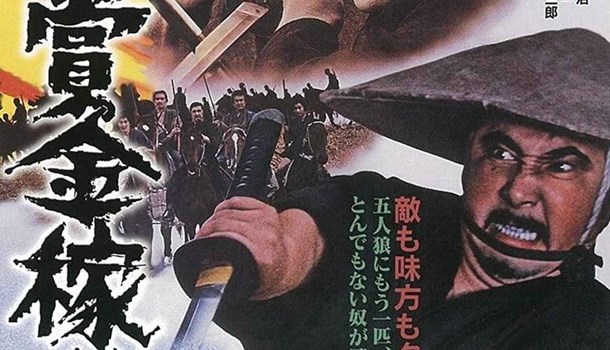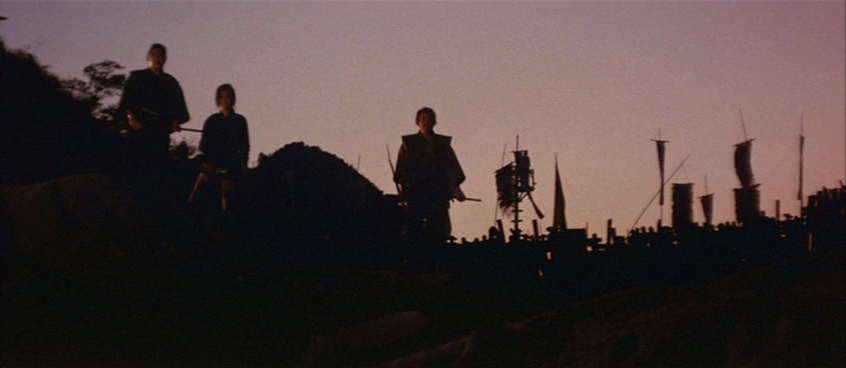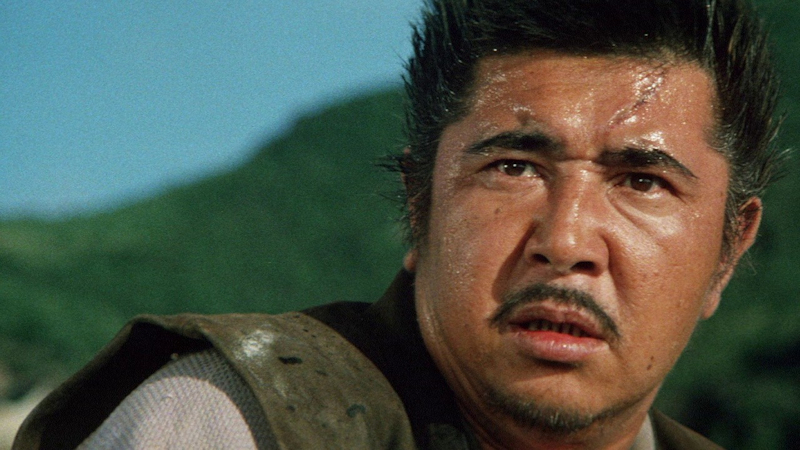
Written by Richard Durrance on 26 Mar 2024
Distributor Radiance • Certificate 15 • Price £36.99
The latest of what has become a bumper crop of releases from Radiance is the Bounty Hunter Trilogy. I was suspecting that there might be a Lone Wolf and Cub vibe here, not that I’m psychic, the presence of Tomisaburo Wakayama was more than enough to give that away, though these films predate his Wolf Cub baby-cart bloodshed.
In I delved, apron on, ready to wash away the crimson from the triumvirate of bloody cinema, Killer’s Mission (1969), The Fort of Death (1969), and Eight Men to Kill (1972). Intriguingly, the first and last films were under the auspices of The Street Fighter director, Shigehiro Ozawa; while the central film, Eiichi Kudo. I’d seen Ozawa’s work thanks to the recent(ish) Street Fighter and Sister Street Fighter sets released by Arrow but Kudo was new to me.
What would Wakayama and his duo of directors have in store for us?
In Killer’s Mission, a Dutch warship attempts to illegally sell arms to the Lord in the Satsuma province with an desire to cause a civil war. The Shogun despatches an assassin, Shikoro Ichibei (Tomisaburo Wakayama) to deal with the matter.
In The Fort of Death, we meet Ichibei in more peaceable times, his bounty hunting now supporting his work as a doctor. Into his clinic stumbles a farmer who has been sent to Ichibei to procure his sword-hand to help protect his village from their corrupt local Lord, who has taken the maxim that there is nothing in life but death and taxes far, far too literally.
In Eight Men to Kill, gold integral to the ongoing economy has been stolen. The loss could bring down the Shogunate and so they hire Ichibei to retrieve it, for it to be delivered before the upcoming eclipse.
Like many of the recent Eureka releases such as Samurai Wolf and Yakuza Wolf, the influence of the Spaghetti Western is writ large, often reflected in the music, certainly the murky morality, and especially in the use of guns, machine guns, canons, pistols, you name; yet intriguingly in this latter instance of the gun, I felt the series was also introducing something a bit different, the theme of the intrusion of modern warfare into tradition. This is reflected in part too by the Dutch warship that is intruding into Japan’s politics, forcing their way in like that American warship, and pushing guns. Also of course it shows the impact of modernity on the samurai (echoes of which can be seen in the recent Blue Eye Samurai animation on Netflix). In our second film, The Fort of Death, there is a very Django moment, samurai, swords in hand to conquer the fort are repelled not through honourable blades but are cut down, and so running towards lead and death; we can see how modernity is beginning to render them superfluous in the traditional sense. Perhaps here too there are echoes of Tatsuya Nakadai in Yojimbo, who so loves his pistol he wants to die with it in his hand, though admittedly it doesn’t help Nakadai in that film, though here in the bounty hunter films the gun and gunplay often usurps the blade.
Killer's Mission
But what of the quality of our three films? Well, it’s interesting as there are no bad films here but there are definitely some intriguing tonal shifts. Killer’s Mission feels like it is written and directed more with the exploitation end of the spectrum in mind. OK, all three films have a certain amount of blood and sex, but Killer’s Mission posits a somewhat different Shikoro Ichibei. He seems to be positioned as if the Shogun’s assassin, and whereas later we find he is a doctor, in the first film this is only apparent in retrospect, his knowledge of poisons rendering him immune, but this inference is only possible once we watch The Fort of Death.
Equally, in Killer’s Mission he is as likely to grab the female ninja Kagero, and try and force his attentions on her (as well as most of the other women he meets) which is a shame because Kagero especially, being a character that can hold her own, loses some of her merits as a character and becomes merely a sex object. This is something that The Fort of Death goes some way to repairing.
But Killer’s Mission is very entertaining despite it's lean toward misogyny, and Ichibei - though violently capable - borders close to the anti-hero. He does have some nice moments though, especially when he does his best Zatoichi impression – and of course Wakayama was the real-life brother of Zatoichi’s Shintaro Katsu. It’s a pleasing moment of lightness and it also plays into the fact that Ichibei as Bounty Hunter is very skilled. He's also very well tooled and I don’t mean his *ahem*, but he’s almost Bond-like in his gadgetry of death.
That said there are some surprisingly fleshed out aspects that other films would have left as rote. The Chamberlain to the Satsuma Lord is unusually complex, and this has a very positive impact on the storytelling and creates some unexpected pathos. All three screenplays were written by, or cowritten by, Koji Tokada, and apparently he put a lot of careful thought into the Chamberlain and it shows, even if other elements are more generic, there’s even a proper Wild West western gunman called Duncan, and other villains similarly chosen for being exotic, rather than for traditional.
The Fort Of Death
Where the trilogy really comes into its own is The Fort of Death. In a story that echoes Seven Samurai, where farmers are being taxed to impossible levels for nothing more than fuelling the goal of their feudal Lord, a man obsessed with elevating his position no matter what. Live and be taxed. Die and be taxed. Just after the film opens, Ichibei is revealed to be a doctor, one who's pursuit of bounties is simply a means to his medical ends which help the poor and needy.

We are confronted then with a very difference bounty hunter in Ichibei and also in a very different film, for The Fort of Death feels a much darker and more disturbing film. It's beautifully shot and superbly paced too. It also feels like an angrier film, the feudal Lord is quite the bastard (albeit in an understated way), with director Kudo handling the action sequences in a visceral manner, integrating his violence in seamlessly into the narrative.. Like the first film there is blood and the occasional chopped limb, but the violence seems more intense and the emotions behind it more palpable. Kudo seems to be channelling Sam Peckinpah’s denouement to The Wild Bunch, and whether or not this is true (both films having come out in the same year: 1969), it has that same bloody feel, and like Seven Samurai a sense of nothing quite being won or lost, rather there is only death and, if lucky, survival.
The narrative economy of the film is shown early, Ichibei calling for what we discover is his band of fighters is mere pigeons being released and them coming to his side, including once again female ninja Kagero, but this time she is a far more active character and Ichibei is unlikely to be pawing her. In fact most of the human emotions on display are face more affecting, including the crazed woman suckling her dead baby. Yes, there are a couple of odd comic moments, with Ichibei being set upon by women in heat, but again he’s this time likely to fight them off, though these comic asides are strange in the context of the film and do not really fit, so you wonder why they were ever filmed. Maybe they were required to add some salacious content?
In the final analysis though these comic missteps barely matter, especially when the film builds up to a great final set piece, which is really quite stunning. The film ends on a final image that is quite beautiful and the dark cinematography throughout often has a painterly quality. The Fort of Death feels the closest the series ever gets from shifting from chanbara to jidaigeki, as there is an underlying social seriousness underpinned by a visual elegance that give the angry action sequences so much more bite. It reminded me of the third film in The Game series that Arrow put, the way in which this is the most cult of a set of cult films. Yes, I was impressed and felt Wakayama may never better this film, he brings a really meaty presence, and you can feel the desperation behind the violence as well as the care of the doctor in his performance. Wakayama is maybe not always challenged in his chanbara films but here everything feels elevated well above and beyond what you have any right to expect.
Eight Men to Kill
So returning director, Shigehiro Ozawa, has a pretty tall mountain to climb in order to best The Fort of Death in Eight Men to Kill. The plot, revolving around gold, feels very much pulled from a western and the music is never more Morricone-esque than is is here. Characters also seem to spend more time on horses than in the other films combined, so again a bit more of the western feel comes through here, which is no bad thing.
Arguably the plot is a bit too convoluted at times, but Ichibei at least is consistent with his character from The Fort of Death. So his reaction to being hired to find the gold and his apparent greed is nothing of the sort, he is still the doctor who wants to open clinics. And why not? The stolen gold surely should be used by the shogunate to provide healthcare and if it will not, Ichibei will use his ill-gotten gains to do so. Assuming he ever gets it.
The bloody ride Ozawa puts us on is perhaps the least exciting of the three but living in the shadow of The Fort of Death this is no surprise. The plot at times is a bit too convoluted and aspects like the presence of the mute hunchback that follows Ichibei feels like it’s reaching for an element of grotesquery that it doesn’t really need. That said the film has a rollicking series of action sequences and again captures some of the social anger of its predecessor, with the shogunate on this outing not always proving worthy of Ichibei’s efforts.
And I have to say for all it may be the weakest film it nevertheless has a terrific ending, with the promised eclipse of the sun being a great visual for the eventual showdown. Emotionally it shows a wonderful cynicism that almost makes up for some of the relative shortcomings of what has come before.
One fascinating aspect to the films I never really recognised was Tomisaburo Wakayama himself. For such a stocky man I always assumed many of his acrobatics were never his own, but no, it’s the man himself who leaps and jumps, providing surprising range of action along with his physical presence, along with the greater emotional intensity he eschewed in the middle film.
As a set of action chanbara films it’s a really intriguing series because the first one is better than average (if suffering from some of the casual misogyny of many of the films of the period) though it also has some unusually deep characterisation that positively influences the story; then it hits an unusual high, with the dark intensity of The Fort of Death, then returning to more recognisable but well-crafted chanbara in Eight Men to Kill. Yet overall it felt better than your average trilogy of action films, even after the first film I felt this, and certainly The Fort of Death is worth the price of admission alone. Moreover, Wakayama is great throughout, and it would have been fascinating if they’d continued to make more films, but of course Wakayama would move onto Lone Wolf and Cub. And that, as they say, is another story.


Long-time anime dilettante and general lover of cinema. Obsessive re-watcher of 'stuff'. Has issues with dubs. Will go off on tangents about other things that no one else cares about but is sadly passionate about. (Also, parentheses come as standard.) Looks curiously like Jo Shishido, hamster cheeks and all.
posted by Richard Durrance on 17 Dec 2025
posted by Richard Durrance on 12 Dec 2025
posted by Ross Locksley on 09 Dec 2025
posted by Richard Durrance on 28 Nov 2025
posted by Richard Durrance on 25 Nov 2025
posted by Richard Durrance on 18 Nov 2025
posted by Richard Durrance on 14 Nov 2025
posted by Richard Durrance on 11 Nov 2025